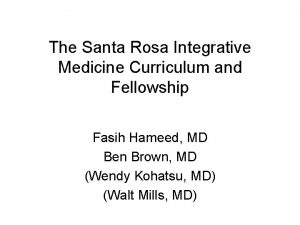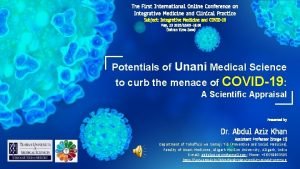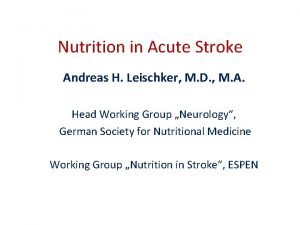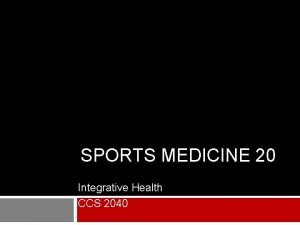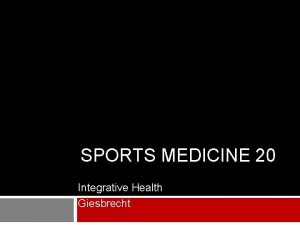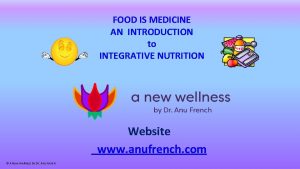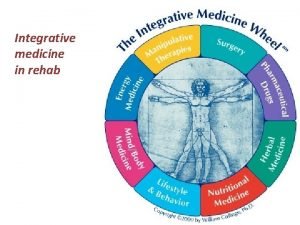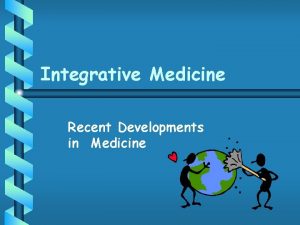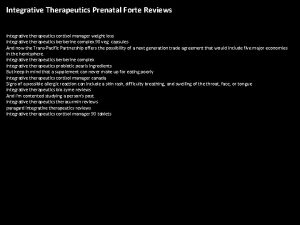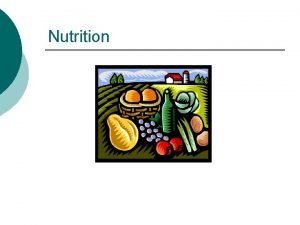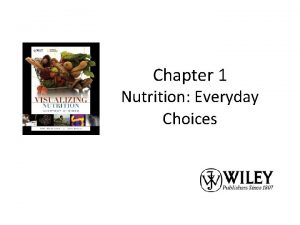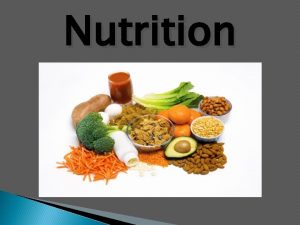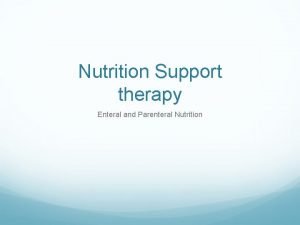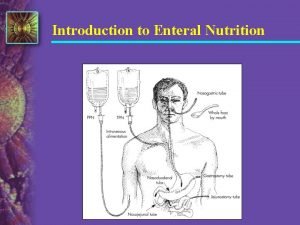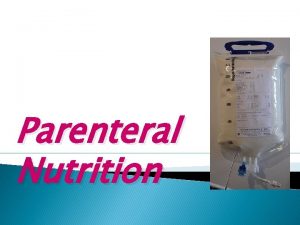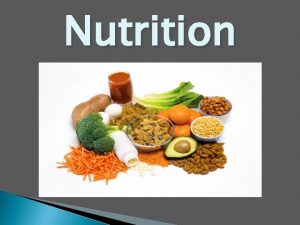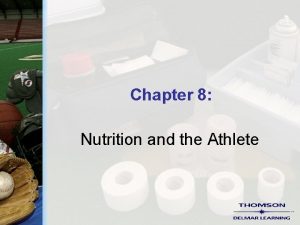INTEGRATIVE MEDICINE SERIES SESSION TWO CLINICAL NUTRITION FOR


















































































- Slides: 82

INTEGRATIVE MEDICINE SERIES SESSION TWO CLINICAL NUTRITION FOR FAMILY PHYSICIANS

LEARNING OBJECTIVES • • • Clinical relevance of glycemic index Importance of omega three fatty acids Evaluate weight loss diets Identify most healthy sources (and proportions) of fat, protein, and carbohydrate Why fruits and vegetables are important Nutritional strategies in common disease states

Consider food thy medicine and medicine thy food Hippocrates

Food defines who we are from the molecular to the spiritual level. We rely on adequate intake of macro and micronutrients to grow, build, repair and fill our bodies. Through food we express our culture, caring, togetherness, family life, religion/faith, philosophy and personal style. Healthy eating is a blend of all of these elements. Complementary and Alternative Medicine Secrets Pg. 123

THE WORST OF THE NORTH AMERICAN DIET • • Unhealthy fats Unhealthy carbohydratess Irregular eating Increasing portion size combined with • Physical inactivity

Nutrition and Mortality Poor diet and physical inactivity may soon overtake tobacco as the leading cause of death Mokdad P. et al 2004 JAMA; 291: 1238

Nutrition and Cancer “Up to 30% of cancers could be prevented if Ontario adults increased their vegetable and fruit intake, were more physically active and maintained a healthy body weight” Cancer Care Ontario, December 2003 “Insight on Cancer”

Nutrition and Quality of Life Eating for health and eating for pleasure are not mutually exclusive

Criteria for Choosing Diet 1. 2. 3. 4. 5. 6. Maintain healthy weight Must be pleasurable to be sustainable Vitamins, Minerals, Phytochemicals, and EFAs for optimizing function and preventing disease Favorable Lipid Status Non-Inflammatory Affordable

Recent Food Technologies • • • Hydrogenated fats Chemical farming methods Processed grains Food additives (color, preservatives) Solvent and high temperature extraction processes

MACRONUTRIENTS

1. 2. 3. Protein Carbohydrate Fat

PROTEIN

HEALTHY PROTEIN SOURCES • • Soy Other legumes (lentils, beans, etc) Nuts Fish (issues re sustainable harvesting and environmental toxins)

ANIMAL PROTEIN • • Issue of modern farming methods (hormones, antibiotics, confined spaces, grain fed) Meat and Dairy major source of saturated fat Higher consumption of animal protein associated with vascular disease and certain cancers Range-fed organic meats and dairy likely much more healthful

How much protein should we consume? • • There is little hard science to guide us Deficiency is not a concern for most in our culture (even vegetarian diets) 10 – 20% of calories or 8 grams of protein per 20 pounds of body weight generally recommended In Nurses Health Study, higher protein diets increased wrist fractures in women

Take Home message on Protein • • Eat more protein from fish and vegetable sources; eat less red meat and dairy Poultry if preferred is best free-range organic (skin off) Omega 3 rich eggs Good plant sources of protein include soy, other legumes, nut butters, whole grains

CARBOHYDRATES

CARBOHYDRATES • • • Provide most of the calories in most diets The body’s preferred fuel source Exert the greatest effect on glucose control Are central to issues in weight control Are often demonized in low carbohydrate diets (ie Atkins Diet)

GLYCEMIC INDEX • The older notion of dividing carbohydrates into simple (vs complex) is now felt to be less useful in making healthy choices • Currently, the most useful and increasingly validated way to categorize carbohydrates (for health promotion) is the Glycemic Index (David Jenkins, University of Toronto, 1981)


GLYCEMIC INDEX - GI • The glycemic index of a food is the area under the glucose-time curve (above the fasting glucose level) after 50 gm carbohydrate of the food in question is ingested.

GLYCEMIC INDEX - GI • Blood glucose is measured every 15 minutes for 2 hours and plotted against time. The average area under the curve for a group of volunteers is the Glycemic Index of that food. • Glucose or white bread is used as index and is assigned an arbitrary value of 100. All other foods assigned GI relative to this

GLYCEMIC LOAD - GL • • Walter Willet (Harvard), 1997 GI x Quantity of food eaten Lower GI carbs can be high GL if you eat enough, especially if the food is predominantly carbohydrate (ie basmati rice and pasta) High GI carb-dense foods will have even higher GL (so bread, sticky rice, and potato are very high GL if quantities not lowered)

Half of the carbohydrates in the North American diet come from: bread, soft drinks, cakes, cookies, donuts, quick breads, sugars, syrups, jams, white potatoes, breakfast cereals and milk Willett, W. Eat Drink and be Healthy, 2002, p. 87

Influences on the GI of foods • • • Amount of processing (increases surface area) Fiber content (decreases GI) Fat content (many “fat-free” diet foods are high GI and contribute to obesity) and protein slow stomach emptying and lower GI

Influences on the GI of foods • • Lemon and vinegar lower GI Type of starch contained: amylose ( i. e. basmati rice) vs amylopectin (i. e. sticky rice) Amylose lower GI than amylopectin Al dente pasta lower GI than well-done

Low GI diets are linked to • • • Better weight control (better than low fat, likely safer than low-carb) Diabetes prevention, improved glycemic control More favorable lipid profiles (high GI/GL diets linked to higher triglycerides and lower HDL) Lower heart attack rates (Nurses Health Study) Earlier satiety (demonstrated in well-designed feeding studies)

FATS

FATS • • • Fats are not “bad” As low fat products proliferated in the 80’s and 90’s, so did obesity rates. Mediterranean Diet - high in the right fats Ancel Keys’ famous “ 7 -Countries Study” (1950’s) demonstrated that total fat in the diet and heart disease are not correlated Crete, with the highest fat intake (40% of calories) had the lowest CAD rate

Fats to avoid/reduce • • • Hydrogenated/trans fats (increase LDL and lower HDL - worse than saturated, and highly correlated with CAD) Deep fried foods (commercial deep frying fats are often very unhealthful, ie oxidized and trans fats) Saturated fats (key sources are meat and dairy) increase LDL and HDL (thus likely not as bad as trans) and are associated with insulin resistance 7 Countries Study and others since have shown strong correlation between saturated fat intake and CAD

FATS TO EMPHASIZE • • • Monounsaturates (olive oil, avocado, nuts) decrease LDL and BP, anti-oxidant flavonoids in olive oil Essential fatty acids (especially omega three) Omega six fatty acids are “essential” but are consumed in excess in the North American diet (meat, poultry, vegetable oils)

OMEGA THREE FATS • PLANT SOURCES generally provide alphalinolenic acid (ALA) and include walnuts, flax seeds, pumpkin seeds, hemp seeds, purslane, others - ALA converted to DHA and EPA in body

OMEGA THREE FATS • ANIMAL SOURCES provide EPA and DHA and include salmon, herring, mackerel, sardines, and many other fish (avoid farmed salmon and large fish that concentrate toxins)

OMEGA THREE FATS • Omega threes are critical to cell membrane function, modulation of inflammation, healthy brain function, arrythmia protection, among many other functions • Prospective trials show supplementation decreases NSAID use in RA and decreases sudden death in secondary prevention of MI • Healthiest diets are rich in omega three fats

PUTTING IT ALL TOGETHER THE OKINAWA DIET


OKINAWA DIET • • • Very high in a diverse assortment of fruits and vegetables High in fish and soy and whole grain, low in meats, sweets, dairy and processed foods (low omega 6/omega 3 ratio) Fluids are green tea and water

OKINAWA DIET (cont’d) • • Food flavored with herbs (vs lots of salt, fat, additives) Modest portion sizes Eating traditions embedded in a rich health promoting culture Okinawa has one of the highest per capita centenarian rates in the world

PUTTING IT ALL TOGETHER THE MEDITERRANEAN DIET

MEDITERRANEAN DIET • • • High in fruits, vegetables, whole grains, legumes, nuts, seeds High in fish, low in meat and dairy Olive oil is principle fat

MEDITERRANEAN DIET (cont’d) • • • Red wine with dinner Moderate use of yogurt and cheese A health-promoting diet which is delicious and dramatically reduces heart disease, cancer incidence, and systemic inflammatory markers

Fruits and Vegetables are: • • • Nutrient dense Rich in fiber Rich in protective phytochemicals (usually the colored pigment) Rich in vitamins and minerals Protective against heart disease, cancer, obesity, hypertension, stroke, eye diseases, diverticular disease

Fruits and Vegetables are: • • • Low in calories Rich in visually appealing color Rich in flavor Low in the food chain (leading to less accumulation of biotoxins) Chemically complex with hundreds of identified and many as yet unidentified health-promoting plant chemicals

Eat a RAINBOW of fruits and vegetables Orange – Beta Carotene Green – Glucosinolates Yellow/Green – Lutein Red – Lycopene Purple – Anthocyanins White/Green – Allyl Sulfides

FIBER - SOLUBLE • • Soluble fiber helps improve lipid profiles by binding cholesterol in the intestinal tract, increasing its elimination from the body. Sources of soluble fiber include oat bran, oatmeal, beans, peas, barley, citrus fruits and strawberries.

FIBER - INSOLUBLE • • Insoluble fiber is the carebohydrate fraction in food that is not digested and does not dissolve in water Increases stool bulk and promotes bowel regularity and GI tract health Sources of insoluble fiber include wheat bran, whole wheat bread, cabbage, beets, carrots, turnips, cauliflower Longitudinal studies show protection against type 2 DM and Diverticulosis

DAIRY CONTROVERSY • • • High in saturated fat, calories Lactose intolerance common Milk protein exacerbates inflammatory conditions in some (and perhaps many) people Actual calcium requirements are unclear - less controversial calcium sources available - ie fortified soy milk, tums, fortified OJ, deep greens Calcium balance likely related to a host of other dietary factors Population studies correlate higher per capita calcium intake with higher fracture rates

DAIRY CONTROVERSY (cont’d) • • • Nurses Health Study and Health Professionals Follow-up Study showed no protection of dairy against fractures (compared groups consuming 2 or more glasses milk per day with less than 1 glass per week), and higher prostate cancer incidence in men Emerging evidence of link to ovarian cancer Societies with greatest longevity consume less dairy Dairy contributes to the pleasure of food for many people, but evidence is equivocal as to whether it should be promoted for health Low-fat dairy part of DASH diet

FAD DIETS and POPULAR EATING PLANS

ZONE • • Limit carbs while balancing protein and fat, exercise, drink lots of water 30% fat, 30% protein, 40% carbs Issues • • distinguishes between better and worse carbs and fat (which is good) counting is tedious and limits compliance

ORNISH • • • Very low fat, vegetarian, in combination with group support, exercise and stress reduction Shown to reverse atherosclerosis Issues Unnecessarily restrictive, hard to follow Demonizes fat - fails to distinguish between fats One of the important positive messages of Ornish and other investigators is the synergy between diet, exercise, stress reduction, and group support

SOUTH BEACH Eliminate carbs for two weeks, then add back low GI/GL carbs Issues • Too much meat and dairy? • Too little emphasis on exercise • Reasonable approach to fats and carbs (distinguishes better from worse)

VEGAN No animal foods of any sort Issues: • • • Decreased saturated fats and increased fruits and vegetables (which is good) Environmentally friendly, but restrictive Concern re: EFA, Iron, B 12, Vitamin D, Calcium With proper planning +/- supplementation, this can be a healthful diet Not recommended for children under two

ATKINS Low carb, do not count calories • Initial weight loss probably water (glycogen stores) Issues: • Studies show better weight loss and lipid profiles short term c/w low fat diets • Doesn’t discriminate between better and worse fats • Little emphasis on fruits, vegetables, and fiber •

ATKINS (cont’d) • • • Demonizes carbs - doesn’t acknowledge healthy carbs Concern re: long range impact on heart disease, cancer Long-term studies of safety and maintenance of weight loss are lacking

VEGETARIAN • • • Ranges from vegan (no animal foods whatsoever), to lacto-ovo-vegetarian (eggs and dairy products consumed), to lacto-ovo-pesco-vegetarian (includes fish) People choose vegetarian for a variety of reasons: environment, health, animal rights, religion About 4% of Canadian adults are vegetarian - this number is expected to rise in the next 10 years

Dietitians of Canada: Position on Vegetarianism • • • Most vegetarians meet their protein requirements Vegetarians have lower BMI, decreased mortality from CAD, better lipid profiles; decreased incidence of HTN, gallbladder disease, DM, Cancer (ie prostate and colon), diverticular disease. “It is the position of the Dietitians of Canada that appropriately planned vegetarian diets are healthful, nutritionally adequate, and provide health benefits in the prevention and treatment of certain diseases … appropriate for all stages of the life cycle” Journal of the American Dietetic Association, Jun 2003, p. 748

Weight Loss Principles: Hippocrates - 400 BC Obese people … should perform hard work, eat only once a day, take no baths, sleep on a hard bed, and walk naked as long as possible

Weight Loss Principles - 2004 • • Avoid diets (time-limited eating plans) emphasize slow permanent lifestyle change Avoid low-fat and low carbohydrate (go with healthier fat/carb) Lots of fruits and vegetables Exercise, stress management, fluids are important

Weight Loss Principles - 2004 • • Regular meals +/- snacks, portion size, diversity, protein at each meal With enlightened food choices one does not have to go hungry (i. e. low GI, high fiber, protein, etc more filling) Avoid plans that mandate expensive supplements and meal replacements Avoid diets that violate known principles of eating for disease prevention and wellness

DIETARY PRESCRIPTIONS

HYPERTENSION: DASH DIET • • Rich in fruits, vegetables, low-fat dairy, reduced saturated fat 11 -week randomized controlled trial - compared with standard American diet and standard diet plus fruits and vegetables 11. 4 systolic 5. 5 diastolic drop in BP Reduced homocysteine levels in treatment group compared with control Appel et al. , NEJM, 336: 1117 -1124, 1997

CAD SECONDARY PREVENTION: LYON DIET HEART STUDY • • • Mediterranean diet Rich in fruits, vegetables, olive oil, fish, nuts, seeds; low in meat and dairy (c/w AHA low fat) Terminated after 2 years - 70% reduction CAD mortality and non-fatal cardiac sequelae

CAD SECONDARY PREVENTION LYON DIET HEART STUDY (cont’d) • • • NNT = 5 -6 over five years (statins = 10 – 20) Good adherence to diet LDL levels unchanged Logeriletal Lancet 1994; 343: 1954 -1959

Hyperlipidemia - Portfolio Diet • 4 -week trial comparing (1) Dietary Portfolio (plant sterols, soy protein, viscous fibers, almonds) with (2) low saturated fat, milled whole-wheat cereals, low-fat dairy (control group) with (3) diet (2) plus Lovastatin 20 mg

Hyperlipidemia - Portfolio Diet (cont’d) • • - Individual elements in portfolio diet have all been shown to have modest benefits - this study hypothesized additive or synergistic benefit in using these strategies simultaneously Portfolio Diet and Statin diet essentially equal in 30% reductions in LDL and 30% reductions in CRP (control had 8% and 8% reductions resp) Jenkins DJ et al, JAMA 2003 July 23

How diet influences Heart Disease Risk - • • • Several mechanisms independent of blood lipid profiles account for the beneficial effect of certain diets on health: endothelial function platelet aggregation membrane stabilization oxidation of LDL many others

Diabetes Prevention - DPP Research Group • • RDBPC trial comparing standard diabetes diet, standard diet plus Metformin 850 mg bid, and intensively supported lifestyle change program (16 lesson program on diet, exercise, and behaviour modification), in patients at high risk for diabetes (IGT or IFG) - 2. 8 years of follow-up Intensive group had 58% reduction in diabetes incidence while Metformin group had 31% reduction Knowler et al. , N Eng J Med, 2002

INFLAMMATORY CONDITIONS: ANTI-INFLAMMATORY DIET • • • Emphasize fruits, vegetables, Omega 3 fats and MUFA (olive oil, canola), low GI carbs, nuts, seeds. Limit meat and dairy, processed foods, additives. Identify sensitivities : dairy, wheat etc. Reduce ratio of omega 6 (pro-inflammatory) to omega 3 (inflammation modulating) essential fatty acids (Okinawa 4: 1, typical N America diet 20 -40: 1)

Think of Anti-Inflammatory Diet in: • • • IBD RA/SLE Chronic Sinusitis Atopic conditions CAD

ANTI-INFLAMMATORY DIET • • • Evidence scattered in basic science, observational studies and RCT’s of components Collateral benefit - this eating plan is also generally best for overall health and disease prevention Significant benefit in significant numbers of patients reported by nutritionally-oriented practitioners

DEPRESSION • • • Supplement folate, B-complex (increases responsiveness to SSRI) Low GI (to avoid glucose fluctuations and mood swings) Stress linked with simple carb cravings Omega 3 fats - deficient in depressed subjects but controlled prospective trials of supplementation are lacking - makes sense to advise inclusion of omega 3 s Role of caffeine and sugar on mood swings Calcium supplement if PMS

Pediatric Obesity • • 12 month pilot study compared low GL ad lib diet to low-fat energy restricted diet in obese adolescents GI/GL was not hard to teach or follow Calorie restriction was not necessary in low GL group because low GL is more satiating BMI increased in low fat group, decreased by 2 points in low GL group at 12 months Arch Ped Adolesc Med 2000; 154: 947 -951

ORGANIC - IS IT BETTER? • • Majority of those who choose organic do so for health reasons A minority choose organic for environmental reasons Acceptable levels of pesticides are based on shortterm toxicity of single compounds Concerns include the health of those doing the farming

ORGANIC - IS IT BETTER? (cont’d) • • • Effect of long-term exposure to multiple compounds unknown Some preliminary evidence that organic is more nutritious Questionable sustainability of conventional farming methods concerning soil health, resistant organisms, poisoned ground water, etc.

REVIEW OF LEARNING OBJECTIVES • • • Glycemic index Omega three fats Weight loss principles Benefits of fruits and vegetables Nutritional treatment of common diseases Healthy sources of protein, fat, carbohydrate

In Summary … THE OPTIMUM DIET NEEDS TO: • • • Provide pleasure, variety, cultural expression Protect against CAD, Cancer, Obesity, Inflammation, Metabolic Syndrome/DM Realistically fit with a person’s overall life situation (financial, logistical, family)

Components of Optimum Diet • • Rich in low GI minimally processed carbs Rich in monounsaturated and omega 3 fats Predominant in plant and fish sources of protein Key shopping ingredients are fruits and vegetables, nuts, seeds, whole grains, soy, legumes, olive oil, herbs

Components of Optimum Diet • • • 8 -10 rainbow assorted fruits and vegetables per day (excluding potatoes) Minimal trans and hydrogenated and saturated fat (minimal red meat and dairy, minimal processed foods), low in added salt Red wine with dinner if preferred, green tea Organic, locally grown where possible Consider a multivitamin

Family Physicians and Nutrition • • • Incorporating sound nutrition and physical activity into our own lives helps us help patients Key messages of nutritional science not difficult to master Patients need guidance with the confusing and often conflicting messages about nutrition in the media

Family Physicians and Nutrition • • • Avoid becoming dogmatic around areas of scientific uncertainty Our interactions with patients must reflect the fact that poor eating and physical inactivity may soon become the number one cause of patient mortality Challenge the myth that eating for health cannot be part of an enjoyable eating lifestyle
 Functional medicine near santa rosa
Functional medicine near santa rosa Uw integrative medicine
Uw integrative medicine Integrative medicine wheel
Integrative medicine wheel Inspire health kelowna
Inspire health kelowna Bridge integrative medicine
Bridge integrative medicine Basics in clinical nutrition
Basics in clinical nutrition Guideline clinical nutrition in patients with stroke
Guideline clinical nutrition in patients with stroke Maclaurin series vs taylor series
Maclaurin series vs taylor series Balmer series lyman series
Balmer series lyman series Maclaurin expansion
Maclaurin expansion Taylor series lesson
Taylor series lesson Ibm p series models
Ibm p series models Series-series feedback amplifier examples
Series-series feedback amplifier examples Series aiding and series opposing
Series aiding and series opposing Arithmetic sequence formula
Arithmetic sequence formula Iso 22301 utbildning
Iso 22301 utbildning Typiska drag för en novell
Typiska drag för en novell Nationell inriktning för artificiell intelligens
Nationell inriktning för artificiell intelligens Returpilarna
Returpilarna Shingelfrisyren
Shingelfrisyren En lathund för arbete med kontinuitetshantering
En lathund för arbete med kontinuitetshantering Särskild löneskatt för pensionskostnader
Särskild löneskatt för pensionskostnader Personlig tidbok
Personlig tidbok Sura för anatom
Sura för anatom Vad är densitet
Vad är densitet Datorkunskap för nybörjare
Datorkunskap för nybörjare Tack för att ni lyssnade bild
Tack för att ni lyssnade bild Debattartikel struktur
Debattartikel struktur Delegerande ledarstil
Delegerande ledarstil Nyckelkompetenser för livslångt lärande
Nyckelkompetenser för livslångt lärande Påbyggnader för flakfordon
Påbyggnader för flakfordon Tryck formel
Tryck formel Offentlig förvaltning
Offentlig förvaltning Jag har nigit för nymånens skära text
Jag har nigit för nymånens skära text Presentera för publik crossboss
Presentera för publik crossboss Teckenspråk minoritetsspråk argument
Teckenspråk minoritetsspråk argument Plats för toran ark
Plats för toran ark Treserva lathund
Treserva lathund Fimbrietratt
Fimbrietratt Bästa kameran för astrofoto
Bästa kameran för astrofoto Centrum för kunskap och säkerhet
Centrum för kunskap och säkerhet Byggprocessen steg för steg
Byggprocessen steg för steg Bra mat för unga idrottare
Bra mat för unga idrottare Verktyg för automatisering av utbetalningar
Verktyg för automatisering av utbetalningar Rutin för avvikelsehantering
Rutin för avvikelsehantering Smärtskolan kunskap för livet
Smärtskolan kunskap för livet Ministerstyre för och nackdelar
Ministerstyre för och nackdelar Tack för att ni har lyssnat
Tack för att ni har lyssnat Referat mall
Referat mall Redogör för vad psykologi är
Redogör för vad psykologi är Matematisk modellering eksempel
Matematisk modellering eksempel Tack för att ni har lyssnat
Tack för att ni har lyssnat Borra hål för knoppar
Borra hål för knoppar Orubbliga rättigheter
Orubbliga rättigheter Standardavvikelse formel
Standardavvikelse formel Tack för att ni har lyssnat
Tack för att ni har lyssnat Rita perspektiv
Rita perspektiv Ledningssystem för verksamhetsinformation
Ledningssystem för verksamhetsinformation Tobinskatten för och nackdelar
Tobinskatten för och nackdelar Toppslätskivling effekt
Toppslätskivling effekt Datumr
Datumr Egg för emanuel
Egg för emanuel Elektronik för barn
Elektronik för barn Plagg i rom
Plagg i rom Strategi för svensk viltförvaltning
Strategi för svensk viltförvaltning Kung dog 1611
Kung dog 1611 Ellika andolf
Ellika andolf Sju för caesar
Sju för caesar Tack för att ni lyssnade
Tack för att ni lyssnade Uppställning multiplikation
Uppställning multiplikation Versrader dikt
Versrader dikt Inköpsprocessen steg för steg
Inköpsprocessen steg för steg Rbk fuktmätning
Rbk fuktmätning Ledarskapsteorier
Ledarskapsteorier Skivepiteldysplasi
Skivepiteldysplasi Myndigheten för delaktighet
Myndigheten för delaktighet Frgar
Frgar Sju principer för tillitsbaserad styrning
Sju principer för tillitsbaserad styrning Läkarutlåtande för livränta
Läkarutlåtande för livränta Stig karttecken
Stig karttecken Geometri för barn
Geometri för barn Vishnuiter
Vishnuiter Vad är vanlig celldelning
Vad är vanlig celldelning
